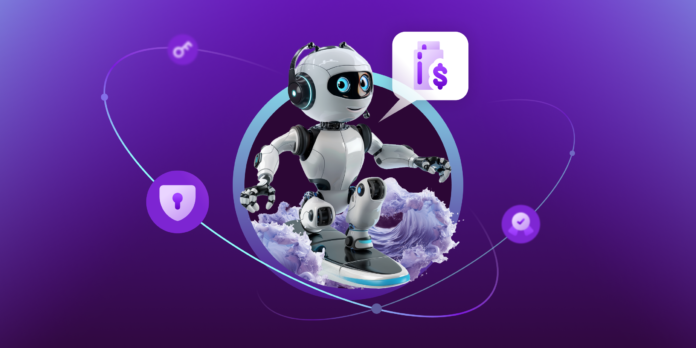The wave of new Artificial Intelligence (AI) has been coming fast for some time now, and lots of financial institutions are looking to hop on. AI is poised to change just about every aspect of business, but with this much momentum there’s a serious possibility of wiping out: Potential AI pitfalls like rogue responses and privacy issues could send your ride crashing and burning. How can you keep your balance and let the AI wave carry you into the future, while keeping your head above potentially treacherous waters?
AI is Mainstream Now, But Not Everyone’s Convinced
While AI has captured the public’s imagination in the world of science fiction for years, and some forms of AI have been in use for decades now, it really was the launch of ChatGPT 3.5 in 2022 that blew the doors wide open for its potential in business use-cases. Now, it seemed that AI was more sophisticated, powerful, and easy to use than ever before. Financial institutions have been looking to implement generative AI in banking through many means. Here’s just some of the emerging AI use cases in banking:
AI in Banking Examples:
- AI chatbot banking, and the use of virtual assistants. These have proven quite popular with users already, showing much promise in conversational AI for banking. These can be as simple as helping you find your routing number, to as complex as providing investment advice.
- AI Fraud detection and prevention. Banking AI can be used to automatically detect potential misuse and report them for swift resolution. These often use Anti Money-Laundering (AML) and Know Your Customer (KYC) analysis.
- Credit, operational, and market risk management. Banks and credit unions are using AI to analyze data and trends, in order to make smarter future decisions. These are also used to create predictive analytics for future customer behavior.
- Underwriting process simplification. AI in Insurance is often used to help ease the underwriting process, attracting more business and attention from agents (particularly from younger agents who prefer digitally-focused channels).
- AI bank statement generators are emerging, allowing financial institutions to automate the process of creating this documentation to save valuable time and effort.
While the potential future of banking AI scenarios are piling up, there’s still a lot that people want to understand before diving right into the technology. Finance is a highly regulated industry, and with the potential for new guidelines and restrictions in the future it’s important to consider the potential downfalls of AI tools so you can prepare accordingly.
Wipeout: When AI Goes Bad
We thankfully have yet to see any rogue AIs like Skynet from The Terminator or HAL 9000 from 2001: A Space Odyssey, but there are still plenty of potential mishaps that could plague an implementation of AI in your organization:
- Hallucinations: While generative AI in banking is impressive in its ability to naturally respond to questions, it’s not always accurate in its responses. While the responses it gives to inputs tend to sound natural and correct, Generative AI rarely fact-checks itself and is prone to providing incorrect or incomplete information as a result.
- Jailbreaking: This is how potential bad actors or mischief makers can take advantage of a consumer-facing generative AI. While these AI chatbots are often loaded with instructions to keep them on topic, user inputs can potentially override these instructions and cause them to say off-topic, inappropriate things. This is how a customer got a Chevrolet dealer’s AI chatbot to agree to sell them a car for $1: By simply instructing the chatbot to accept anything they said as true. This, clearly, could lead to many issues when not taken into account.
- Explainability: Due to how massive the data pools that generative AIs utilize for their responses, it’s hard to figure out what, if any, sources they may be pulling answers from. The time you may be spending trying to double-check and confirm answers given by AI in this way may counteract any of the time savings it could offer.
- Security and Compliance: There are several legal concerns when it comes to generative AI in the finance space: Potential leaked personal information, biased training data, and hallucinations causing misinformation. Without thorough security measures, these can all lead to fines, legal action, and lost consumer trust.
If all this has you second-guessing AI in your business, then don’t worry – there’s a way you can get all the benefits of banking AI technologies without any of these potential downsides.
Keep it Safe with Responsible AI
Responsible AI is exactly what it sounds like: AI that has a specific focus on responsibility. AI that has addressed these concerns and isn’t just looking to deliver a technologically advanced product, but one you can also feel safe using. Here are the three qualities you should be looking out for when wondering if an AI really is responsible:
- Safe: Safe AI should come with a secure platform for it to operate from, with financial-grade security measures such as encryption and triple-hot redundancy.
- Turnkey: Turnkey AI is built specifically for the needs of the financial industry, without any retrofitting or additional programming needed to make it work. This ensures the AI is compatible with your existing workflows and requires no extensive training.
- Proven: Proven AI is able to demonstrate immediate, replicable results. It has a track record of success and justifies its existence right after the purchase, not potentially several years down the road.
With these guiding principles in mind, you can surf the AI wave with confidence without worrying about going under. The future of AI in banking should be guided not by hype, but by responsibility.
Want to learn more about the AI Wave and Responsible AI? Check out our recent whitepaper for more info.





